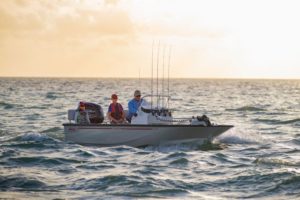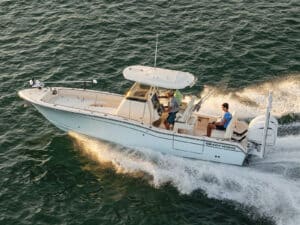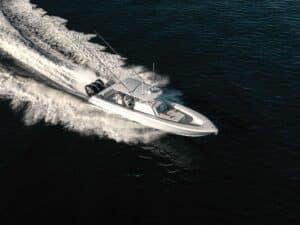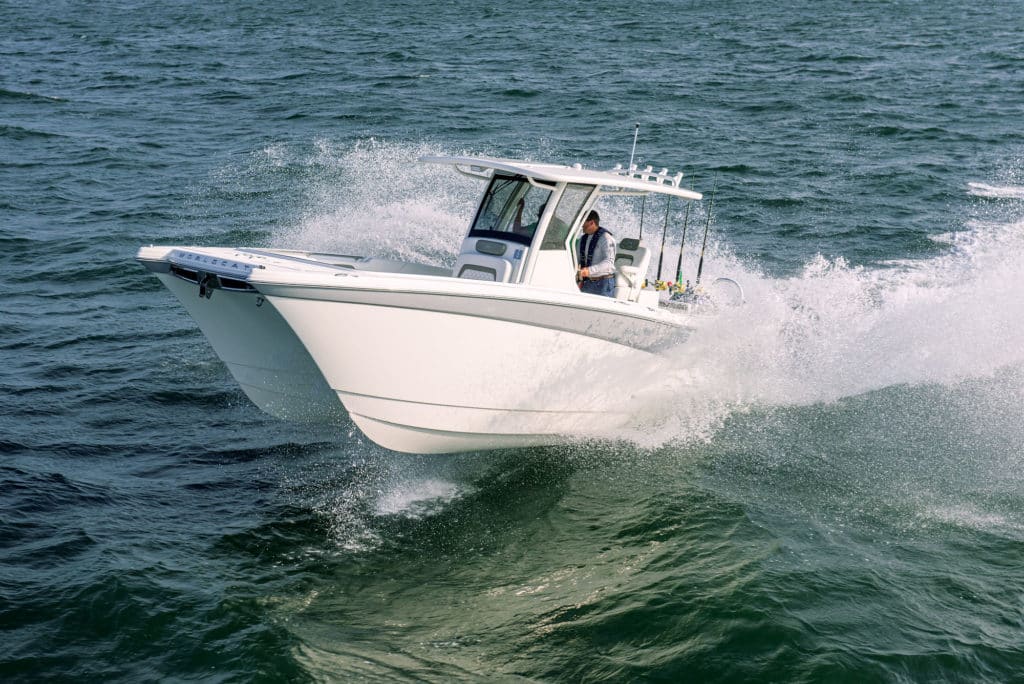
I wouldn’t describe my father as a hardcore boat guy. He owned a cabin cruiser and a few sailboats during my childhood, but he spent much more time on the golf course.
That’s why it came as a big surprise, in the mid-1960s, when Dad—ever the gadget enthusiast—built himself a boat: a catamaran, in fact.
Now, I don’t recall spending much time aboard his homemade multihull, but I do recall sailing with him aboard the Hobie Cat he bought shortly thereafter. Cat boats evoke fond memories for me, however I’ve been a monohull powerboat owner ever since.
In the offshore-fishing world, I represent one side of the historic divide between V-hull owners and cat-boat enthusiasts. Make no mistake: V-hulls still dominate, but more American boat buyers have started gravitating to cats during the past decade.
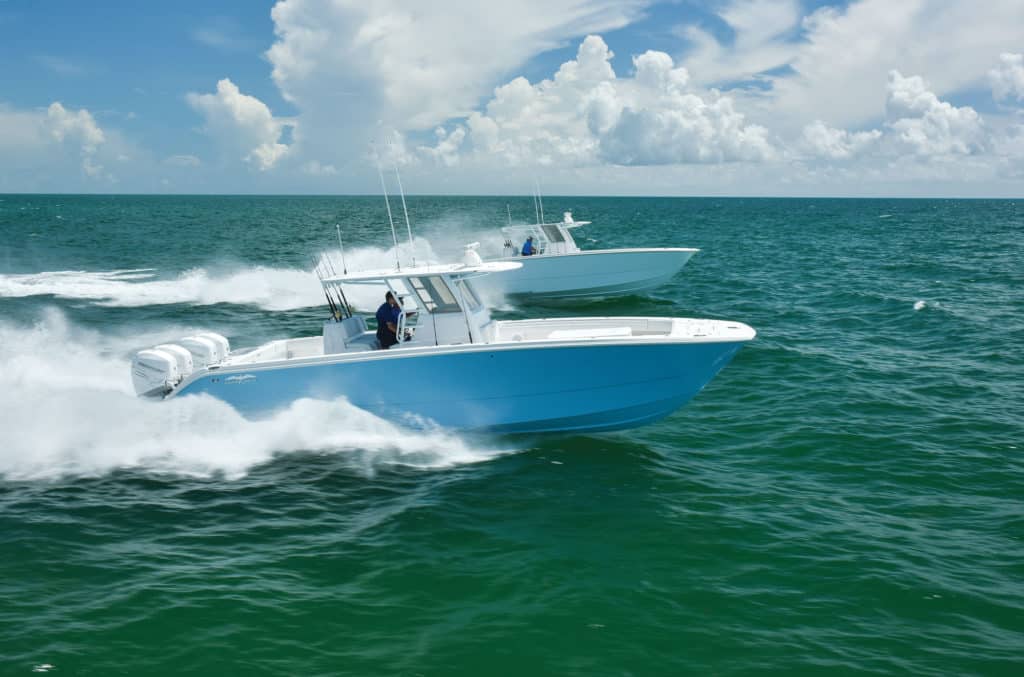
New Designs
“I’ve been impressed to see how [the two groups] have stayed segregated, if you will,” explains Bill Cordes, director of sales for Invincible Boats, which has introduced 40- and 37-foot catamaran offshore-fishing boats over the past two years, and yet remains successful with its popular stepped-V-hull vessels. “The guy coming in who’s already on a V-bottom boat is coming in for another V. But we’re getting new looks from guys who are cat guys, who are looking for a bigger alternative.”
Invincible and companies such as Freeman, Seahunter, Insetta and Calcutta are driving a resurgence in multihull-boat building, particularly in the offshore-fishing world. At press time, Calcutta was poised to splash its new 480, an express boat that will be available in inboard and outboard versions; Invincible is expected to add a 35-footer to its multihull stable; and TAG Boats, a new South Carolina company, should introduce its 36-footer. In the next six months, Barker Boatworks plans to debut a new 40-foot cat, and HHH BoatWorks will launch a 35-footer.
Depending on how they’re built, cat designs can offer some general advantages over V-hulls, including a better ride in rough head seas, a broader, more stable platform with little roll at rest, shallower draft, better fuel efficiency and greater deck space.
“On my first World Cat sea trial, I remember getting ready to stabilize myself as I saw that first big wave approaching,” recalls Capt. Shane Jarvis, of Sport Fish Panama Island Lodge (fishpanamatoday.com), which operates two World Cat 33TEs. “But the boat never jumped. It just cut through the wave like butter and didn’t buck like I was accustomed to.”
In Panama, captains do a lot of run-and-gun-style fishing and trolling, but they also drift live baits and jig. Offshore runs can total 20 to 50 miles. “The wide 10-foot-6-inch beam of our cats allows plenty of room to move around, and for multiple anglers to cast and fish with minimal to no roll when drifting,” he says.
In fact, outside the United States, catamarans have been popular for a long time.
“Certain parts of the world embraced cats a long time ago—places like South Africa, Australia and New Zealand, where the distances are great and the seas can be pretty rough,” says yacht designer Michael Peters, well-known in the fishing world for creating everything from large inboard sport-fishing vessels to stepped-hull center-consoles. Peters is also currently designing Barker’s new catamaran.
“Yet, the American market never did [embrace cats]. It seems that nobody really got the attention until Freeman. Why that was, I couldn’t completely explain, but suddenly there was a boat that seemed to get good balance and aesthetics, and the fishing world took notice.”
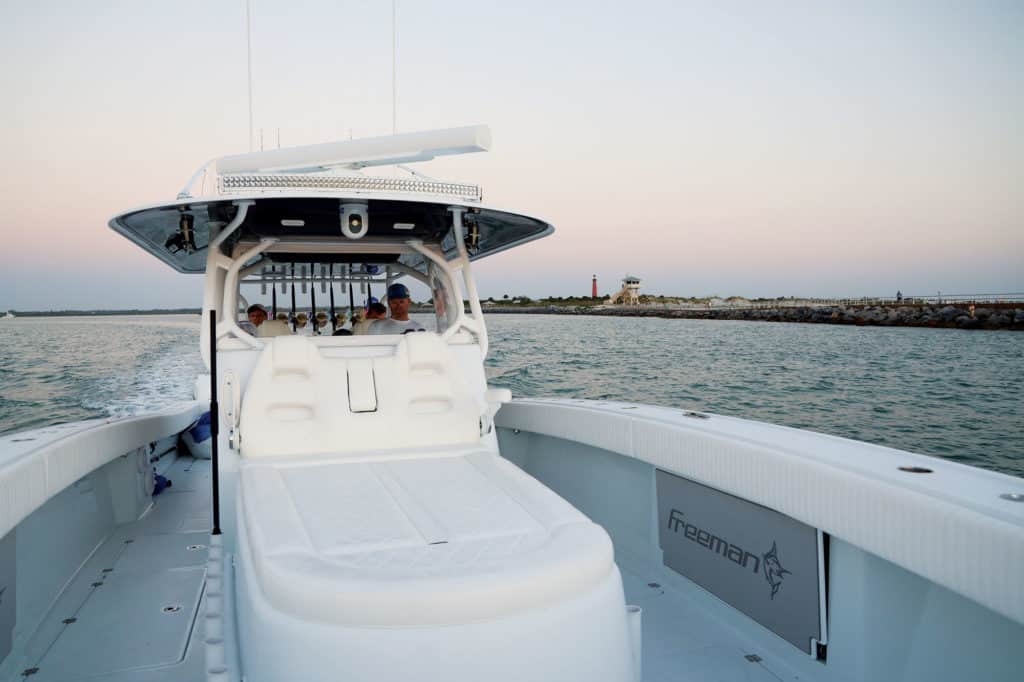
Billy Freeman started Freeman Boatworks in 2006, after years of working in boatyards and welding shops, and cutting up old hulls to rebuild them in his off time. “I bought an old cat, and wanted something bigger and better,” Freeman says. “I called up [naval design engineer] Jesse Rhodes, who was an unknown back then, and I said I wanted to design a cat. I said, ‘If it doesn’t work, it’s on me.’”
Quite simply: It worked.
Freeman says he started calling fishing guides in Venice, Louisiana, who make their living running well offshore into sometimes gnarly seas. “I didn’t have to talk them into a cat,” he says.
Freeman looked to resolve what are considered classic catamaran performance and handling issues, including bow steering and pulling and jerking in certain sea conditions. Traditional cats rode very well into head seas, and remained more stable at rest because of their wide beam. But in a following sea, “they could be a complete handful,” says Peters, who also spent 25 years building offshore racing catamarans. “In high-speed turns, they do what we call a ‘destroyer turn,’ as in a Navy vessel. They bank outboard.”
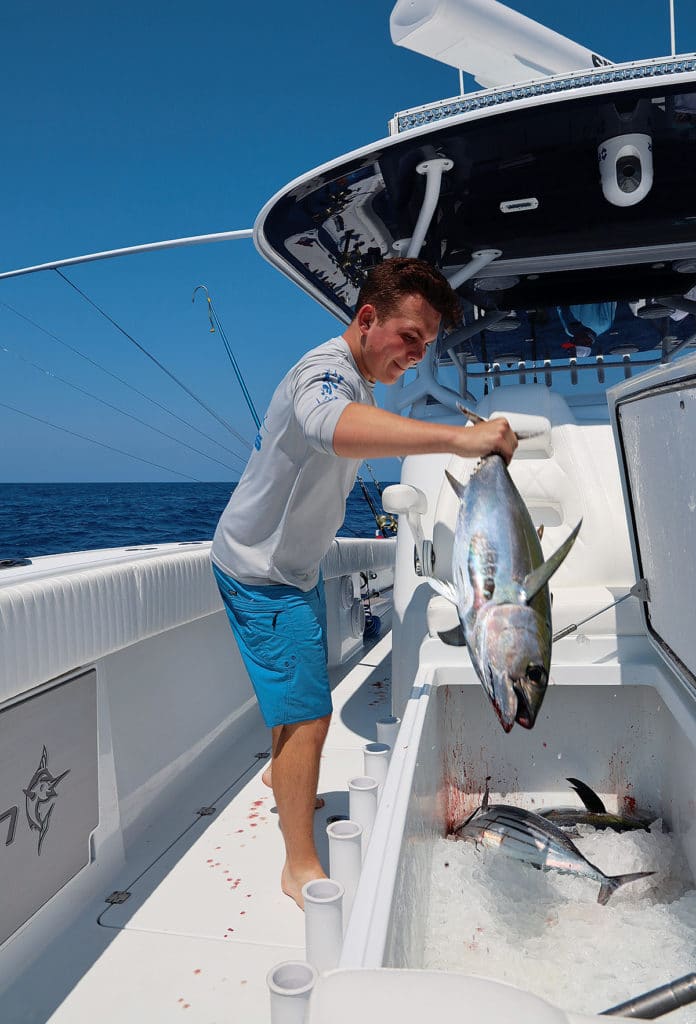
Cordes says Invincible sought the same handling innovations from its designers Morrelli & Melvin, a California firm. In fact, the Invincible boats bank inboard like traditional V-hulls.
Peters says the resurgence of the planing catamaran, and its subsequent redesign, has resulted from a perfect merge of technology and timing. “Part of it is the new, large outboards that put these boats in the 60-plus mph range,” Peters says.
Curb Appeal
Freeman’s boats also looked better than traditional boxy cat boats, which feature near-vertical sides. Longtime multihull specialist World Cat—which evolved out of the original handful of Carolina cat builders from the 1980s—saw the new design trend and created its X series, beginning with the 280CC-X in 2017.
However, World Cat’s customers want greater amenities and comforts than do 100 percent hardcore fishermen. “This buyer [of the 280CC‑X] is 80 percent fish, 20 percent cruise,” says Wyatt Lane, World Cat’s national distribution manager. “Our design process started with a sales scope.” Criteria for that include the various attributes the boat needs for salability such as its speed, comfort factors and price point.
“With the 28, one of these requirements was aesthetically we had to work on changing the traditional cat look and raising that bar,” he says. “The deck cap and hullsides are a challenge. You can’t have a lot of flare because of how skinny the hull is. So you’ve got to be creative.”
The cats of the ’80s came from a similar surge of creativity, but they fell short for a variety of reasons. “Early designs were flawed. They were somebody’s backyard dream,” says Steve Ellis, who founded Calcutta Boats in 1996. “They didn’t have enough reserve buoyancy, and they all bow-steered really badly and sneezed really badly.” (Sneezing occurs when spray shoots out the front of the tunnel and blows back toward the helm.)
Those boats featured knife-edge entry angles, which could easily bury the bow into oncoming waves. “Very few of the cats were really designed” by naval architects, Ellis continues. Calcuttas and many of today’s modern cat builds come from the desks of designers such as Jim Ryan, of Locus International, who drew up the Calcutta 480.
Invincible’s Cordes says the evolving industry piqued his company’s interest. “I think the overall versatility of the boat has got the attention of a lot of folks,” he says. “The sheer volume of storage, and then you get into the fishing platform that it is. It really is something new and exciting.”
Venice, Louisiana, captain John Cole, with Southern Catch Outfitters, has run Invincible’s 40 Cat for the past two fishing seasons. “Invincible did a lot of homework and spent some money,” Cole says. “There are two aspects I like best: how it runs and the internal layout.”
He says it took a little time to learn how best to trim out the boat and engines, but he says he now has high confidence and that the handling is very predictable.
The layout is a mix between hardcore fishing boat and family boat, which serves all of his clients. “The 12-foot beam carries all the way to the bow. There’s so much deck space and square footage,” he says. “I can have a customer fighting a fish next to the console, and I can walk around him if I need to get ahead of him. Plus, the in‑deck storage on the cat boats is just ridiculous.”
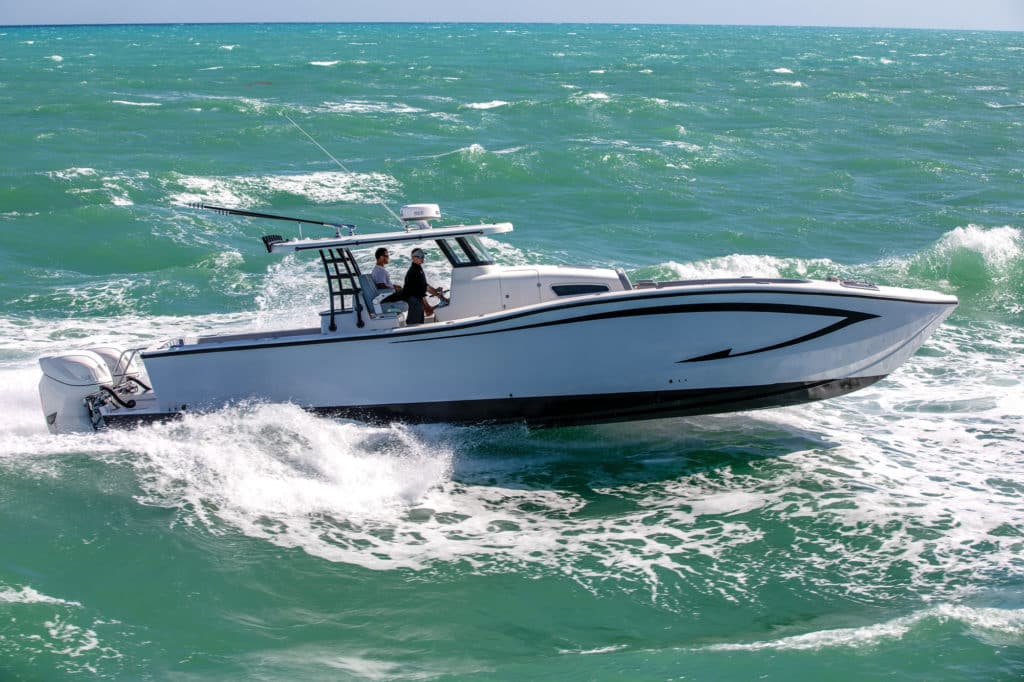
Hull Variations
The majority of today’s catamarans feature planing hulls—designed to rise up on top of the water—rather than displacement hulls, which plow through the water. They can have asymmetrical or symmetrical sponsons. The former focuses more on forcing air down through the tunnel to create lift, says Rob Coffey, director of sales and marketing for Insetta Boatworks, which builds a 45-foot semicustom asymmetrical cat.
Looking at the bow of a boat with asymmetrical sponsons, what you’d see would look like a V-hull split down the middle: The inside sponson edges would be straight from hull bottom to the water, and the outside edges would angle. The symmetrical hull would look like two small V-hulls side by side.
Coffey says the asymmetrical sponsons float higher and help the boat turn with less outboard force.
Insettas also feature steps, as do Invincibles and several others. Steps do for cats what they do for V’s: They break the surface tension, and create better speed and efficiency.
With asymmetrical sponsons, “you’ve helped correct the turning, but you’ve not made the head sea ride quite as good,” Peters says. “We’re really at the beginning of the curve in perfecting the designs.”
To help the new Barker boat perform better in a head sea, Peters says he made the bow fuller, not as sharp and pointed. A too-sharp angle of entry means the bow can act like a rudder. “What we opted for was saying, if you put this much horsepower in the boat to go 60-plus mph, we want a boat that can absorb all that horsepower and not become difficult to drive,” he says. “We opted for a boat that we feel will bank more appropriately in a turn.”
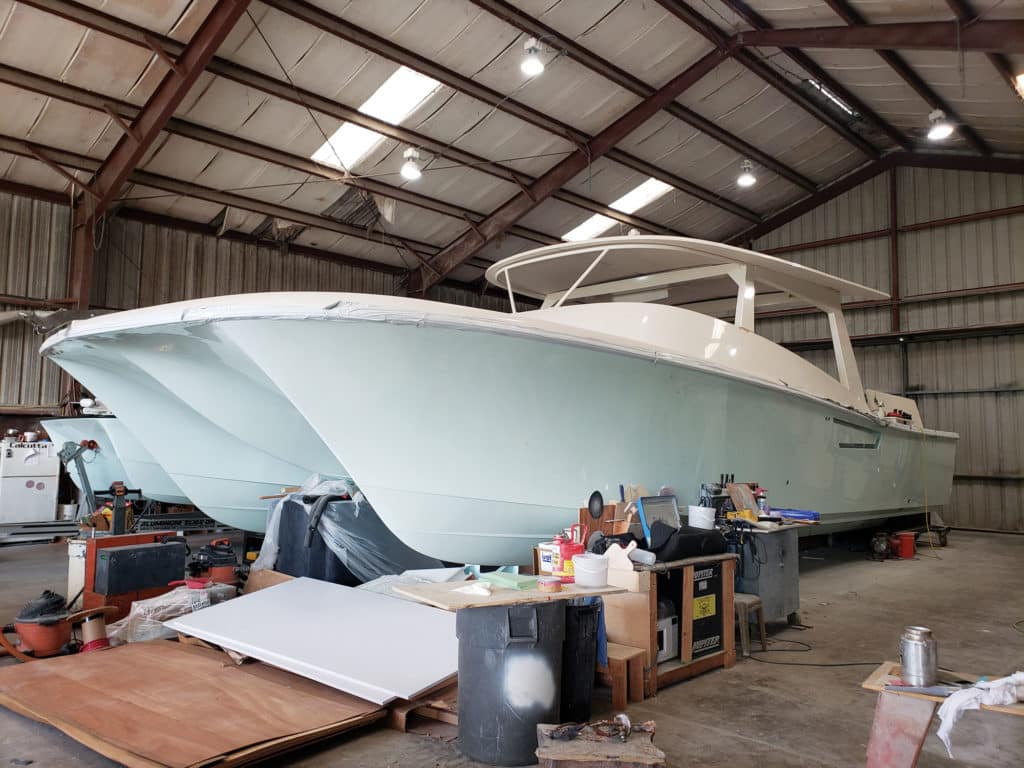
Creature Comforts
Center-console catamaran builders also face a challenge when creating interior space. A boat that features two hulls with a tunnel between means no step-down beneath the console. To compensate, the builder can increase the interior-console height, but “how do you do that and not have a telephone booth in front of you?” World Cat’s Lane asks.
Cole says the V-hulls he owned prior to his Invincible cat always featured a spacious cabin with a V-berth. However, he says, that just became a black hole for storage anyway.
Companies such as Insetta, Calcutta and World Cat, whose customers often want overnighting capability, have come up with creative solutions. Insetta’s 45, for instance, features an interior-console full-size berth, a plumbed head, and a kitchenette with a microwave, freshwater sink and shower wand. At the bow, Insetta designed twin single V-berths.
Cat builders have also addressed the problem of bow sneezing. For instance, World Cat formed what it calls a Vector Pod in the tunnel near the bow. It helps break up incoming water, creating aeration and reducing friction. As air and water pass through the narrowing tunnel aft, the mixture increases in velocity with a subsequent decrease in forward pressure.
Read Next: Boat Review: Invincible 40 Catamaran
In the next decade, designs will continue to evolve, Peters says. Fishing-boat cat hulls are now at a point in their evolution that deep-V hulls experienced in the 1960s and ’70s. “We’ve got a perfect confluence of things happening. Development happens when things overlap at the same time,” he says.
Billy Freeman says that 35 years ago when the Carolina cats emerged, some builders predicted that monohulls would become obsolete. They didn’t. “I think they didn’t because [the early cat builders] screwed it up. They built on a budget. They had to cheap it out to get to the same price as a monohull.”
Clearly today’s crop of resurgent cat builders has planned a better outcome.
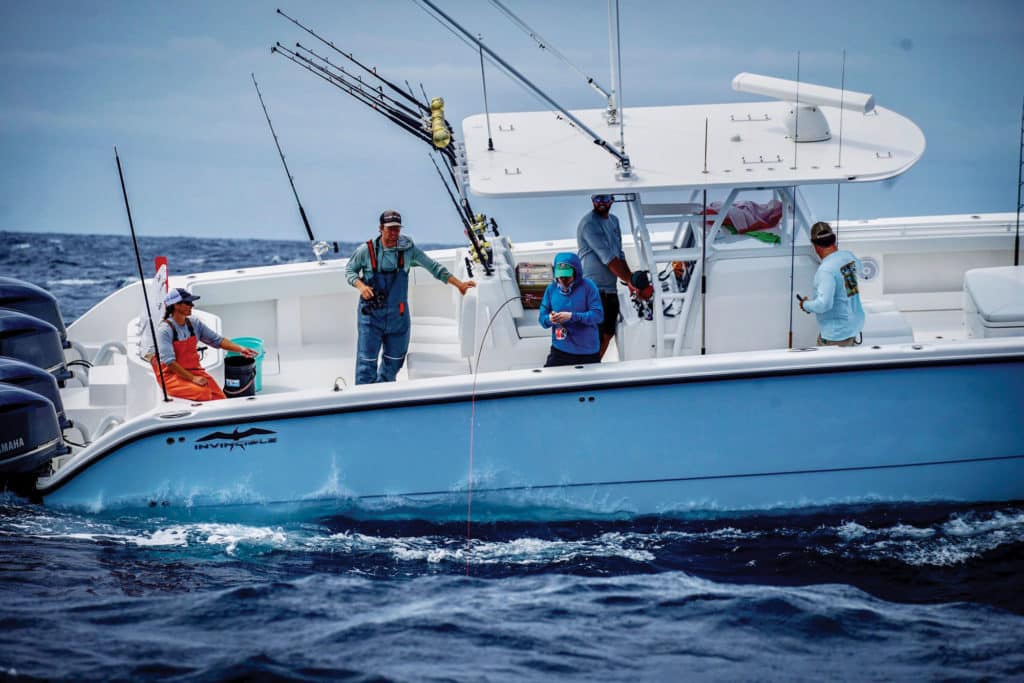
Crazy Cat Traits
Out of necessity, catamarans employ a number of design characteristics most anglers would not expect. For instance:
1. Most cats feature a higher deck level than V-hulls, and in fact, the whole boat is generally taller, Calcutta Boats founder Steve Ellis says. That can result in higher gunwale heights and freeboard, making it tougher for anglers to reach the water to release a fish aft—without the assist of a side dive door or an aft tuna door.
2. An offshore cat boat’s height and its tunnel also necessitate at least twin outboards or quads—one or two per side—though Calcutta and Insetta have designed vessels for inboard power.
3. Trim tabs can create problems as well, competing with the outboards for space along the width of the sponson. However, yacht designer Michael Peters says interceptors—blades that drop down vertically—prove less problematic to mount.
4. The wake behind a cat is generally smaller than that created by a deep-V. That’s due to the weight of the boat over two hulls. The narrower hulls push less water out of the way, Peters says.

